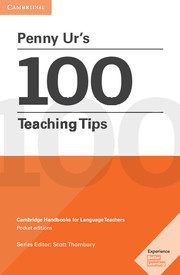Book contents
- Frontmatter
- Contents
- Why I Wrote this Book
- Beginning and Ending the Lesson
- The Coursebook
- Discipline
- Error Correction
- Games
- Grammar
- Group Work
- Heterogeneous (Mixed-Level) Classes
- Homework
- Interest
- Listening
- Pronunciation
- Reading Comprehension
- Speaking Activities
- Teacher Talk
- Testing and Assessment
- Vocabulary Teaching
- Writing
- P.S.
- Index
- Photo Acknowledgements
The Coursebook
Published online by Cambridge University Press: 17 November 2023
- Frontmatter
- Contents
- Why I Wrote this Book
- Beginning and Ending the Lesson
- The Coursebook
- Discipline
- Error Correction
- Games
- Grammar
- Group Work
- Heterogeneous (Mixed-Level) Classes
- Homework
- Interest
- Listening
- Pronunciation
- Reading Comprehension
- Speaking Activities
- Teacher Talk
- Testing and Assessment
- Vocabulary Teaching
- Writing
- P.S.
- Index
- Photo Acknowledgements
Summary
A good coursebook is often an essential basis of the course content, and can make a real contribution to successful learning. But it needs to be used critically and selectively, not just followed page by page.
7 Use the coursebook – selectively
8 Vary the way you use exercises
9 Allow lots of right answers
10 Recycle tasks
7 Use the coursebook – selectively
The coursebook is a valuable tool, but that doesn't mean you have to use all of it. Choose in advance what you feel is essential to get through, and what can be skipped if you don't have enough time.
Some writers have suggested that we shouldn't use coursebooks, on the grounds that they de-skill and disempower the teacher and deny us the right to teach creatively. But in fact it's a useful – or even essential – tool for most of us. I certainly needed one. I didn't have the time to find my own texts or exercises or plan my own course programme. On the other hand, using the coursebook doesn't mean going through it page by page doing everything the writers provide. There are bound to be bits you don't like so much. Maybe the content of a text isn't suitable for your students; maybe it's just boring; maybe you just can't see how a task would work in your classroom; maybe there's just too much of it.
Anyhow, the main tip here is to take the time to look through the book at the beginning of the course and note for yourself what you’re definitely going to use, what you definitely aren’t, and what you may use if you have time. Do the same, in more detail, at the beginning of each unit. If you don’t, you might find later that you have to skip some really nice bits, or aren't teaching some tasks or texts thoroughly enough, simply because you’ve run out of time.
Sometimes you can get your students to help you. Ask them to look forward through the unit (or the entire book) and tell you which bits they are more, or less, interested in doing. It's a good way of giving them a preview of the material and can help you make decisions as to what to prioritize.
8 Vary the way you use exercises
The usual way to do coursebook exercises in class is the classic teacher-student ‘ping-pong’.
- Type
- Chapter
- Information
- Penny Ur's 100 Teaching TipsCambridge Handbooks for Language Teachers, pp. 8 - 12Publisher: Cambridge University PressPrint publication year: 2016

